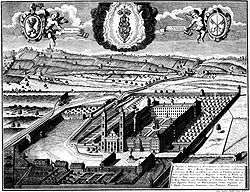Imperial Abbey of Weissenau Reichsstift Weißenau | |||||||
|---|---|---|---|---|---|---|---|
| 13th century – 1802 | |||||||
 Engraving of Weissenau Abbey, Johann Mathias Steidlin, 1734 | |||||||
| Status | Imperial Abbey | ||||||
| Capital | Weißenau | ||||||
| Common languages | Alemannic German | ||||||
| Religion | Roman Catholicism | ||||||
| Government | Elective principality | ||||||
| Historical era | Middle Ages | ||||||
• Founded | 1145 13th century | ||||||
• Raised to abbey | 1257 | ||||||
• Gained Reichsfreiheit | mid-to-late 13th century | ||||||
1283 | |||||||
• Joined Council of Princes | 1793 | ||||||
| 1802 | |||||||
• Bought by Württemberg | 1835 | ||||||
| |||||||
Weissenau Abbey (German: Kloster Weißenau, Reichsstift Weißenau) was an Imperial abbey (Reichsabtei) of the Holy Roman Empire located near Ravensburg in the Swabian Circle. The abbey, a Premonstratensian monastery, was an Imperial Estate and therefore its abbot had seat and vote in the Reichstag as a prelate of the Swabian Bench. The abbey existed from 1145 until the secularisation of 1802-1803.